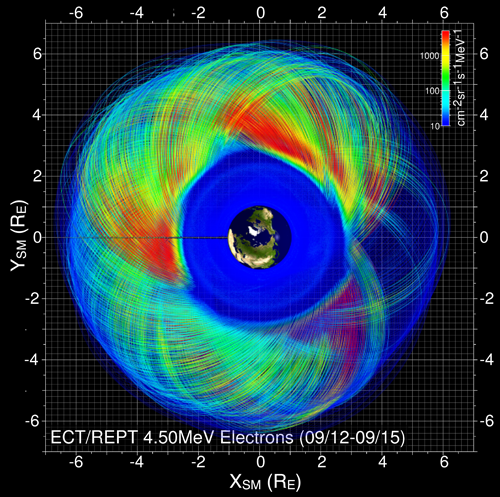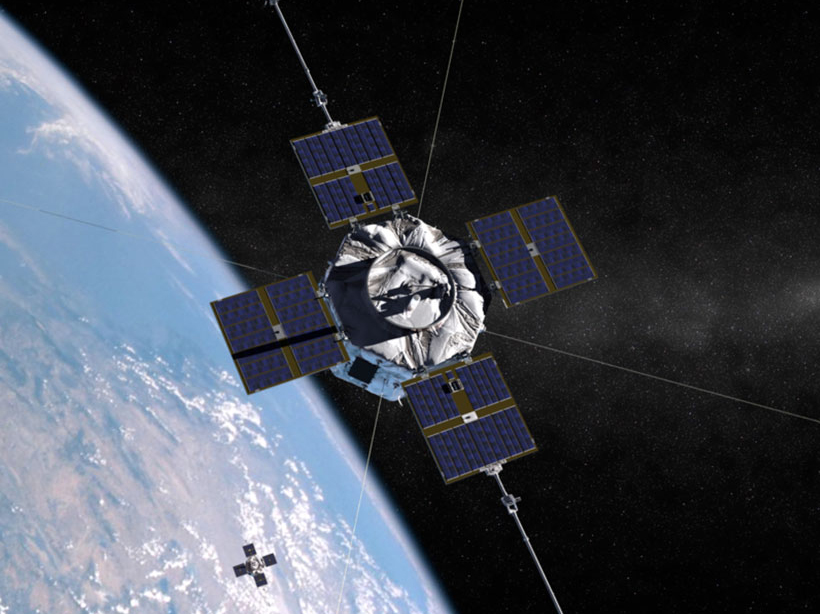The morning of 30 August 2012 saw an Atlas 5 rocket launch of the twin Radiation Belt Storm Probes, the second spacecraft mission in NASA’s Living with a Star program. The probes settled into an elliptic orbit that cut through Earth’s radiation belts, home to highly variable populations of energetic particles dangerous to astronauts’ health and spacecraft operation. Renamed the Van Allen Probes soon after launch, the spacecraft are equipped with instruments designed to determine how these high-energy particles form, respond to solar variations, and evolve in space environments.
During their prime mission, the Van Allen Probes verified and quantified previously suggested energization processes, discovered new energization mechanisms, revealed the critical importance of dynamic plasma injections into the innermost magnetosphere, and used uniquely capable instruments to unveil inner radiation belt features that were all but invisible to previous sensors.
Now, through an extended mission that began 1 November 2015, the Van Allen Probes will advance understanding of the dynamics of near-Earth particle radiation. The overarching objective of this extended mission is to quantify the mechanisms governing Earth’s radiation belt and ring current environment as the solar cycle transitions from solar maximum through the declining phase.
Earth’s radiation belts are a unique natural laboratory for developing our understanding of the particle energization processes that operate across the universe.
The Van Allen Probes mission extends beyond the practical considerations of the hazards of Earth’s space environment. Twentieth century observations of space and astrophysical systems throughout the solar system and out into the observable universe show the universality of processes that generate intense particle radiation within magnetized environments such as Earth’s. Earth’s radiation belts are a unique natural laboratory for developing our understanding of the particle energization processes that operate across the universe.
Effects of the Solar Cycle Decline
The sunspot number reached a peak in April 2014. From historical measurements, we can expect that radiation belt activity will keep intensifying with the decline of the solar cycle: The biggest radiation belt enhancements during geomagnetic storms of two previous solar cycles occurred in their declining phase. As the solar cycle wanes, high-speed solar wind streams become more prominent compared to the solar coronal mass ejections that tend to prevail during solar maximum. Not surprisingly, the two biggest geomagnetic storms of this decade occurred last year, on 17 March and 21 June 2015.
The local time positions of the apogees of the Van Allen Probes’ orbits drift westward and complete a full circle around Earth over a period of about 2 years (Figure 1). By the end of the extended mission (roughly June 2019), the Van Allen Probes will be the first inner magnetospheric mission to circle Earth four times, enabling us to quantify how the relative role of various acceleration and loss mechanisms changes with the decline of the solar cycle.
Understanding Local Particle Energization
Particle acceleration mechanisms have been a key focus of the Van Allen Probes mission. The probes have provided the first definitive evidence that, at times, local particle acceleration within the heart of the radiation belts dominates over other processes that invoke transport and adiabatic compression of particle population from distant regions. The local acceleration is attributed to quasilinear particle interactions with electromagnetic waves called whistler waves. Whistler waves transfer energy from copious low-energy particles to sparse high-energy particles.
At the same time, the probes have also discovered highly unexpected nonlinear wave structures in the heart of the radiation belt. Such structures can rapidly energize very low energy (~10 electron volts) electrons up to intermediate energies (~100 kiloelectron volts (keV)), thereby providing a seed population for subsequent acceleration to radiation belt megaelectron volt (MeV) energies by the whistler waves. The probes have also observed whistler waves with unusually large amplitudes that are likely to more rapidly accelerate keV particles to MeV energies with nonlinear processes. A key theme of the probes’ extended mission aims to sort out the relative importance of quasilinear and nonlinear interactions for the buildup of radiation belt intensities.
To determine the relative importance of nonlinear interactions, we need to measure the evolution of the wave fields and particle distributions along field lines. In the extended mission, Van Allen Probes will provide two unique opportunities for such measurements. First, by adjusting the orbital phase of one spacecraft slightly with respect to the other, we can roughly align them along the same magnetic field line and thus sample field-aligned evolution of particles and wave fields.
Coordinating with Japan’s Exploration of Energization and Radiation in Geospace (ERG) spacecraft, planned for launch in summer 2016, will afford us the second opportunity to sample wave interactions simultaneously at different magnetic latitudes. ERG, by design, will sample at higher magnetic latitudes than the probes. Using three-point measurements from ERG and the probes will provide a more global view of wave-particle interactions at different magnetic latitudes, important for quantifying nonlinear effects.
Investigating Particle Loss
Defining particle loss mechanisms is critical to understanding dynamic variability of the radiation belt intensities. The Van Allen Probes and the associated Balloon Array for Radiation-Belt Relativistic Electron Losses (BARREL) have conducted joint experiments for quantifying particle precipitation, which is the scattering of particles from radiation belts into the atmosphere. The BARREL mission launched multiple high-altitude balloons to measure precipitation of relativistic electrons into the atmosphere along field lines that map to the radiation belts. Within the belts, the Van Allen Probes measure the plasma waves that drive these losses.

Exceedingly close correlations have been observed between the so-called whistler-mode “hiss” waves and electron precipitation modulations, suggesting that losses capable of depleting radiation belt intensities can happen globally on time scales as short as 1 to 20 minutes.
Another process that can rapidly deplete radiation belt intensities during geomagnetic storms is the occurrence of magnetosphere distortions that can cause the particles to stream out of the magnetosphere into the interplanetary environment.
It is a goal of the Van Allen Probes extended mission to understand the relative importance of precipitation and interplanetary particle losses. NASA’s Magnetospheric Multiscale (MMS) mission, launched in March 2015, provides an ideal opportunity to observe directly these escaping electrons at the magnetosphere boundary (the magnetopause) while the Van Allen Probes measure inner magnetospheric losses and the processes that drive these losses. During major loss events, the MMS spacecraft will skim the dayside magnetopause region for extended intervals. With its unusually sensitive energetic electron sensors, MMS will directly measure escaping radiation belt electrons.
Ring Current Generation
The buildup of the intermediate energetic ion population (reaching keV) during geomagnetic storms creates a source of hot plasma pressure in the inner magnetosphere that drives the so-called global “ring current” system that encircles Earth. This ring current controls the magnetic field configuration, which in turn governs the motion of radiation belt particles. Energetic ions also provide the energy source for an array of different wave modes that play a significant role in radiation belt particle acceleration and loss.
A surprising discovery of the Van Allen Probes prime mission was that a substantial fraction of hot plasma pressure is produced by dynamic small-scale injections that rapidly (in a matter of minutes) transport hot particles radially into the inner magnetosphere. Such injections were known to be common within the magnetotail but were previously thought to be infrequent in the inner magnetosphere.
The structure and occurrence rate of the injections remain unknown, and the amount of hot plasma transported remains poorly quantified. The extended mission will quantify the properties of small-scale injections in the inner magnetosphere and explore their role in the buildup of hot plasma pressure during storms. This investigation will be greatly facilitated by the recent adjustment of the spacecraft’s orbits, which doubled the cadence of simultaneous two-point, radial-aligned measurements, necessary to quantify the properties of dynamic injections.
The Mission Continues
Over the past 3 years, the Van Allen Probes mission has radically changed our understanding of Earth’s inner magnetosphere and radiation belts.
Over the past 3 years, the Van Allen Probes mission has radically changed our understanding of Earth’s inner magnetosphere and radiation belts. As of October 2015, the Van Allen Probes’ bibliography contains more than 210 publications, including a number of articles published in high-profile journals such as Nature and Science.
With all instruments returning quality data, both spacecraft healthy, and the remaining propellant sufficient to support spacecraft operations well into 2019, we expect many more quality publications and science discoveries from the extended mission. Stay tuned!
Author Information
A. Y. Ukhorskiy and B. H. Mauk, Johns Hopkins University (JHU) Applied Physics Laboratory (APL), Laurel, Md.; email: [email protected]; D. G. Sibeck, NASA Goddard Space Flight Center (GSFC), Greenbelt, Md.; and R. L. Kessel, JHU APL and NASA GSFC
Correction, 7 April 2016: An earlier version of this article included embedded videos of chorus waves that are not exactly the waves mentioned in the text. The article has been updated to remove these videos and instead hyperlink to a collection of audio clips from the Waves instruments on the twin Van Allen Probes.
Citation: Ukhorskiy, A. Y., B. H. Mauk, D. G. Sibeck, and R. L. Kessel (2016), Radiation belt processes in a declining solar cycle, Eos, 97, doi:10.1029/2016EO048705. Published on 23 March 2016.
Text © 2016. The authors. CC BY-NC-ND 3.0
Except where otherwise noted, images are subject to copyright. Any reuse without express permission from the copyright owner is prohibited.

